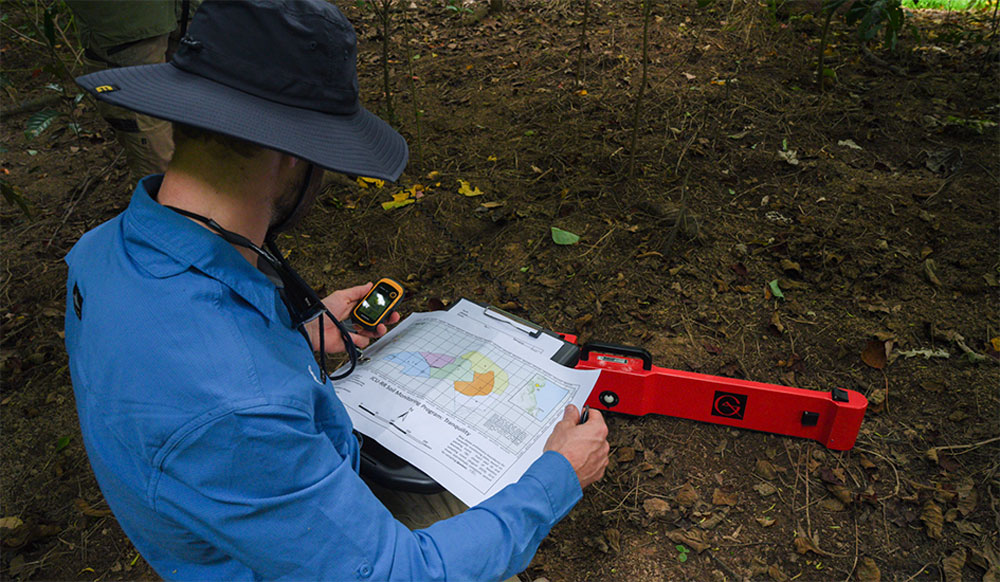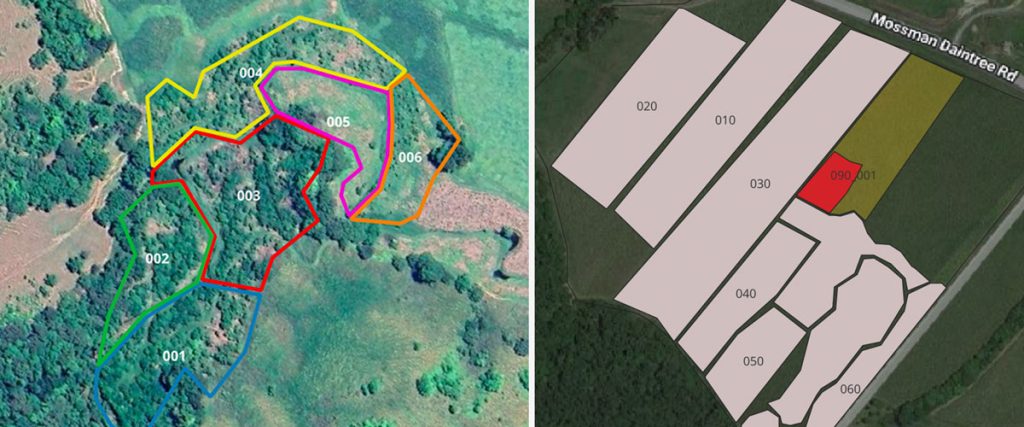Measuring our impact – Why Rainforest Rescue is ‘doing more with data’

Soil Scientist Fred Holden using an EM Inductor to test electrical conductivity of the soil.
Image: Martin Stringer
“Data is the new oil.”
Back in 2006, a British mathematician named Clive Humby coined that phrase, acknowledging that a readily available resource could, when processed and turned into something useful, have massive potential. Fast forward nearly two decades and data technology is driving innovation in every sector. Even rainforest restoration and conservation. Which led Rainforest Rescue to wonder, what gains might come from rainforest data?
Recently, we caught up with Sigrid Wilkens, Rainforest Rescue’s many-hatted star of land labouring, business partnerships and, more recently, data and technology optimisation, for a good chat about the potential of the ‘new oil’ for the future of rainforests.
Hey Sigrid, what’s prompted Rainforest Rescue to ‘do more with data’?
Good question. It’s a mix of things, mainly in response to our supporters and organisation wanting to do more for the rainforests!
We’re surrounded everyday by data points that can help deepen our understanding of the environment. If we look out the window (of the native nursery’s office in Cow Bay), we see thousands of plants that are a complex mix of data, there’s all that lovely soil that is full of data, the weather, the migration of animals, our time spent on the land, it’s all data. We’re fortunate that we also have access to technology, partners and methodologies that can bring the data to life, so it becomes meaningful. Then our curiosity really kicks in!
What a great way to think about data. But why does this matter?
Well, when we began this project, we asked ourselves ‘How can we be more effective with the funding that our supporters provide?’ and ‘How can we effectively quantify the impact our actions have?’. Together, this helps us to consider in depth the economics of what Rainforest Rescue is doing to protect and restore rainforest.
For our supporters, we want to ensure that we ‘sweat’ every last cent that goes into the environment. By doing so we’re aiming to make short-term changes that have a compounding difference in the long term. As an example, we need resources such as water, organic fertiliser and pest control to help restoration plots thrive. In reviewing the data, we identified some quick wins that our site management team has implemented to lessen the need for these resources. When we scale this up across all the restoration plots over a longer time, we can see capital savings that we will reallocate into other projects. We can achieve more with less!

Rainforest restoration site mapping using QGIS software
What kind of datasets is Rainforest Rescue capturing and synthesising?
Quite a few different datasets actually. We have a mix of quantitative and qualitative data, some of which is captured by our team out on the land, as well as through technology that is being used to measure specific things like carbon in a biomass.
For example, at our rainforest restoration sites we are monitoring and recording tree loss and attrition rates of the individual trees planted. In nature, the success rate of plants and animals depends on several environmental factors, so it’s natural that some will do better than others. By recording the loss of trees we’ve planted, we can determine why some haven’t survived or reached maturity. This data is shared with our nursery team, which helps us collaborate on species selection for restoration plots and ways to support plant resilience.
In contrast, we also have a mapping program taking place. Using software called QGIS, we are defining each plot of restoration using GPS coordinates. Within these plots we’re recording tree density and other data points, such as species type. Now there is enhanced accuracy with our plots, we can overlay other datasets. So, if we take the recordings from restoration maintenance, or tree planting density experiments, we can make inferences from cross-referencing the data. It’s really exciting!
“We’re building up a detailed, multi-dimensional view of the restoration process and reintroduction of biodiversity into restored rainforest habitat.”
If we consider where this approach to data takes Rainforest Rescue’s methodologies, we’re building up a detailed, multi-dimensional view of the restoration process and reintroduction of biodiversity into restored rainforest habitat. This view is important because it helps landowners to understand the value of natural assets and the potential future value of restored habitat.
How important is data to our supporters?
For Rainforest Rescue and our supporters, we want to be able to share tangible outcomes that have come from funding and inputs like volunteering. Being able to quantify the difference that all our efforts are making is crucial.
A simple example of this is the updates on flora and fauna identified at Rainforest Rescue’s portfolio of protected sites. Recording a species of, say, a frog, snake or bird frequenting rainforest habitat can be an indicator of the health of that environment. Hayden, our land manager, is overjoyed when he sees certain insects appearing amongst a tree planting plot. For me, cassowary chicks are symbolic of the difference our supporters are making.
Sigrid, this is incredibly exciting to hear. What else is happening? Can you tell us about any innovations taking place?
Sure! Rainforest Rescue has several experimental projects under way. Supporters may have read about the organic pest control methods at the native nursery (see ‘Embracing the Buzz’, pages 18-19 of Rainforest Rescue’s 2023 Annual Report). Again, this is a valuable dataset for measuring the effectiveness of natural resources.
An investigative project that is particularly exciting for me is the impact of mycorrhizal fungi in the rainforest soil. Land that will be or is being restored tends to have poor quality soil, usually because of past intensive agricultural practices. It takes many years to improve soil on this land, so we’re experimenting with fungi that could accelerate or support the improvement process through helping root structures across communities of plants. The data from this project could feed into our overall restoration methodologies. And, looking at soil samples under the microscope and seeing the difference the fungi make is really cool!
We’re also working with James Cook University to determine our methods for carbon measurement and data modelling. Soil-based and tree-based carbon is something that Rainforest Rescue can have a clear impact on. With JCU, we’re using FullCAM, or Full Carbon Accounting Model, to equate a volume of carbon into trees planted and grown over a period of time over a given area.
Organisations need the FullCAM data to define carbon accounting, such as offsets or reductions. Rainforest Rescue is now involved in the Land Restoration Fund through restoration projects in the Daintree rainforest, and FullCAM is a key part of the methodology of our restoration work.
So, is data the new oil?
Well, we hope our supporters can see the value of the data we are capturing, especially through sharing stories like this one.
If it means we can use funds more effectively, connect biodiversity and carbon values of restored land and ensure that rainforests are protected for future generations, then I’d say data is extremely valuable!
We agree, Sigrid. Rainforests truly are priceless places on Earth.
Want more good Rainforest news in your life?
Subscribe to our eNews | Follow us on Instagram | Like us on Facebook | Subscribe to our YouTube channel
Help Protect Rainforests Forever
Donate to Protect Rainforests Forever | Become a Rainforest Guardian | Partnership Options

